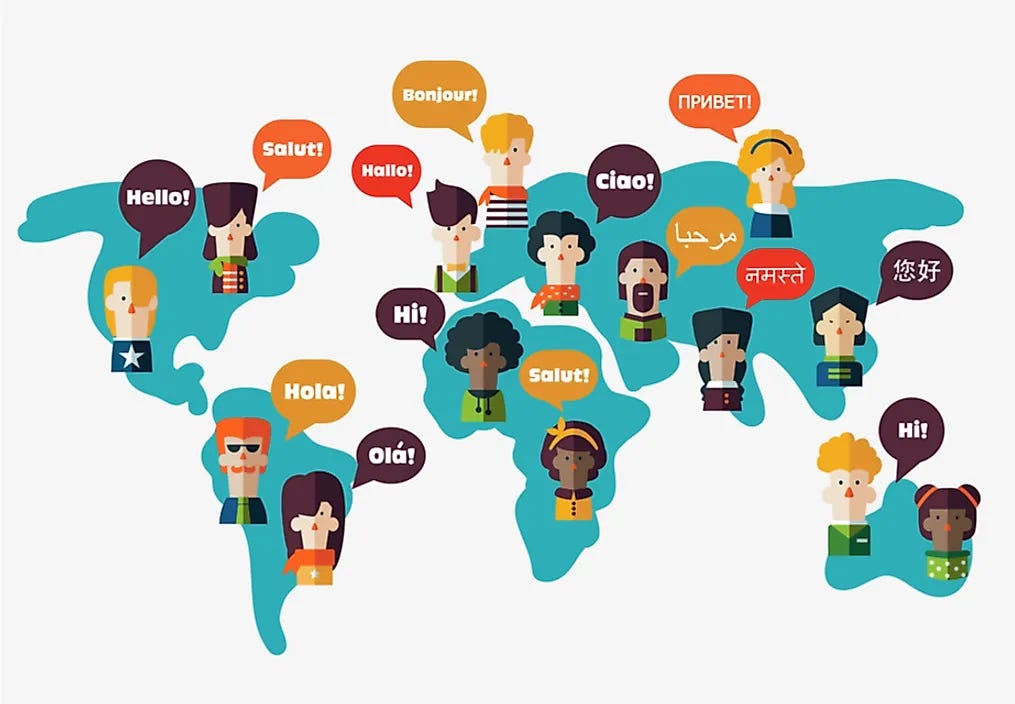Teaching Writing Tip of the Week: Celebrating Multilingualism as a Form of Resistance—Official Language My Foot!
An (other) Executive Order came out this week which hurts and complicates—again and even more—the lives of our students. By EO, English is supposed to now be the “official language” of the United States (though the Gulf of Mexico is still the Gulf of Mexico, and Canada is NOT the 51st state). As the New York Times reports, so far, the order may be more “symbolic” than a mandate demanding specific actions by federal programs. Nevertheless, “the pronouncement was the biggest victory yet for the country’s English-only movement, which has long been tied to efforts to restrict bilingual education and immigration to the United States.” A commenter on the Indian Country subreddit put it more bluntly: “The added bonus is of course the racist dog whistle of what it means to be an American—speaking fluent English in this case.”
All of this language conjures up (most recently) the nightmarish memory of the 2002 Unz Initiative, which legislated that “all public school children [in Massachusetts] must be taught English by being taught all subjects in English and being placed in English language classrooms”—with very few exceptions. It also smacks of the earlier linguicide brazenly and brutally carried out in residential boarding schools against indigenous children across this continent. Those schools are no longer open, the Unz Initiative is no longer the law, and additive bilingual programs have been growing up and down the North Shore. But the specter of an official language and “English Only”—especially in this climate of hate, fear, chaos—is one more reason we should all be on guard: for ourselves, for our students.
For this tip, I turn, then, to reminders of the incredible funds of knowledge our students who are multilingual bring to our classrooms, discussions, and lives—and to ways we can defiantly and joyously leverage the gifts of these students to better everyone’s learning. For this tip, I draw from and build on Nguyen and Commins’ (2020) “Teaching for Equity” and their “Cultural, Linguistic, Equity, and Responsiveness” (CLEAR) paradigm. Here are just a few important ideas they share which demonstrate how we can push back—rightly and confidently—against the restrictionism underlining English as an official language, and instead, embrace and celebrate the wealth of languages in our classrooms and all around us. So consider: might you integrate any or some of the following ideas into your curricular goals?
Linguistic Landscapes: Invite students to interview, document, and share the linguistic and cultural landscape of their communities through photos, video, and any other means of communication they might imagine. Invite them to analyze, share, and reflect on these various landscapes.
Authentic, Meaningful, and Relevant Assignments in Multiple Languages: Explore with students how what you’re teaching relates to their daily lives, identities, and languages. How can they share what they’re learning with others in their home languages, and for what purpose? Model and think it through with them, brainstorming specific actions they might take using what they have learned to solve problems or make a positive impact on their family, friends, or communities. Example: One of my students is currently researching domestic violence. For one of her genres, she’s creating a flyer. She’s creating her flyer in English and Spanish. Her group mates joined in, copying and citing her design but translating the text into Korean, Chinese, and Swahili. The discussion of “words for” and cultural attitudes towards domestic violence took on new weight in this class.
Create a language portrait of your class, listing and discussing all the languages spoken. Then encourage students to use their multilingualism to deepen their understanding of academic content and view all their languages as contributing to their academic success. For instance, if students are brainstorming or freewriting, invite them to do so in their home languages first (the goal is a list of ideas, not a list in English, right?). Invite them to reflect on these experiences and how their home languages support their development of English—and vice versa. This is just one example of “translanguaging” (for more, see a previous tip).
Activate background knowledge and background languages: As Nguyen and Commins write, “Knowledge and skills for linguistically responsive teaching include [ ] ways to learn about the linguistic and academic backgrounds of multilingual learners.” In my last tip, I talked about activating background knowledge as a vital way to prime students for learning new knowledge and making our content comprehensible. We can also activate this background knowledge by inviting (and activating) students’ use of home languages: let them google and skim texts about your topics in their home languages (which they can share in comparison with the information you present in English). Discuss the similarities and difference in how the content is discussed—what terms are used, how do they translate, are there unknown words in students’ home languages?
One more example: Words for Which There Are No English Equivalents. Saudade (Portuguese) “The feeling of longing for an absent something or someone that you love but might never return.” Ya’aburnee (Arabic) “A declaration of one’s hope that they’ll die before another person because of how unbearable it would be to live without them.” Forelsket (Norwegian) “The euphoria experienced as you begin to fall in love.” I use these words for various purposes: to emphasize how sound and meaning of words across languages are mostly arbitrary, and also to consider the music of language and poetry. How might you use them?
If ever there was a time to push back against an “official” policy about English, it’s now. I hope this tip has helped you think of new ways to invite MULTIPLE languages into your classroom—as a means of honoring the linguistic and cultural identities of our students even as we teach our content. As a means of celebrating multilingualism and cultural diversity. As a means of resistance. If you try any of these activities, please let me know.
Peace--Amy


